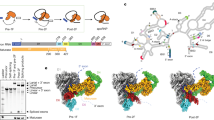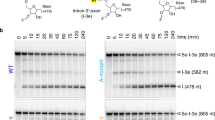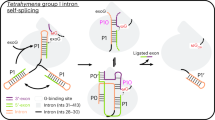Abstract
DEAD-box helicases are conserved enzymes involved in nearly all aspects of RNA metabolism, but their mechanisms of action remain unclear. Here, we investigated the mechanism of the DEAD-box protein Mss116 on its natural substrate, the group II intron ai5γ. Group II introns are structurally complex catalytic RNAs considered evolutionarily related to the eukaryotic spliceosome, and an interesting paradigm for large RNA folding. We used single-molecule fluorescence to monitor the effect of Mss116 on folding dynamics of a minimal active construct, ai5γ−D135. The data show that Mss116 stimulates dynamic sampling between states along the folding pathway, an effect previously observed only with high Mg2+ concentrations. Furthermore, the data indicate that Mss116 promotes folding through discrete ATP-independent and ATP-dependent steps. We propose that Mss116 stimulates group II intron folding through a multi-step process that involves electrostatic stabilization of early intermediates and ATP hydrolysis during the final stages of native state assembly.
This is a preview of subscription content, access via your institution
Access options
Subscribe to this journal
Receive 51 print issues and online access
$199.00 per year
only $3.90 per issue
Buy this article
- Purchase on Springer Link
- Instant access to full article PDF
Prices may be subject to local taxes which are calculated during checkout





Similar content being viewed by others
References
Linder, P. Quick guide: DEAD-box proteins. Curr. Biol. 10, R887 (2000)
Diges, C. M. & Uhlenbeck, O. C. Escherichia coli DbpA is an RNA helicase that requires hairpin 92 of 23S rRNA. EMBO J. 20, 5503–5512 (2001)
Huang, H. R. et al. The splicing of yeast mitochondrial group I and group II introns requires a DEAD-box protein with RNA chaperone function. Proc. Natl Acad. Sci. USA 102, 163–168 (2005)
Solem, A., Zingler, N. & Pyle, A. M. A. DEAD protein that activates intron self-splicing without unwinding RNA. Mol. Cell 24, 611–617 (2006)
Halls, C. et al. Involvement of DEAD-box proteins in group I and group II intron splicing. Biochemical characterization of Mss116p, ATP hydrolysis-dependent and -independent mechanisms, and general RNA chaperone activity. J. Mol. Biol. 365, 835–855 (2007)
Del Campo, M. et al. Do DEAD-box proteins promote group II intron splicing without unwinding RNA? Mol. Cell 28, 159–166 (2007)
Lehmann, K. & Schmidt, U. Group II introns: structure and catalytic versatility of large natural ribozymes. Crit. Rev. Biochem. Mol. Biol. 38, 249–303 (2003)
Lambowitz, A. M. & Zimmerly, S. Mobile group II introns. Annu. Rev. Genet. 38, 1–35 (2004)
Toor, N., Hausner, G. & Zimmerly, S. Coevolution of group II intron RNA structures with their intron-encoded reverse transcriptases. RNA 7, 1142–1152 (2001)
Toor, N., Keating, K. S., Taylor, S. D. & Pyle, A. M. Crystal structure of a self-spliced group II intron. Science 320, 77–82 (2008)
Qin, P. Z. & Pyle, A. M. The architectural organization and mechanistic function of group II intron structural elements. Curr. Opin. Struct. Biol. 8, 301–308 (1998)
Pyle, A. M. & Lambowitz, A. M. in The RNA World 3rd ed., Vol. 43 (eds Gesteland, R. F., Cech, T. R. & Atkins, J. F.) Chap. 17 469–505 (Cold Spring Harbor Laboratory Press, 2006)
Koch, J. L., Boulanger, S. C., Dib-Hajj, S. D., Hebbar, S. K. & Perlman, P. S. Group II introns deleted for multiple substructures retain self-splicing activity. Mol. Cell. Biol. 12, 1950–1958 (1992)
Michels, W. J., Jr & Pyle, A. M. Conversion of a group II intron into a new multiple-turnover ribozyme that selectively cleaves oligonucleotides: elucidation of reaction mechanism and structure/function relationships. Biochemistry 34, 2965–2977 (1995)
Qin, P. Z. & Pyle, A. M. Stopped-flow fluorescence spectroscopy of a group II intron ribozyme reveals that domain 1 is an independent folding unit with a requirement for specific Mg2+ ions in the tertiary structure. Biochemistry 36, 4718–4730 (1997)
Su, L. J., Waldsich, C. & Pyle, A. M. An obligate intermediate along the slow folding pathway of a group II intron ribozyme. Nucleic Acids Res. 33, 6674–6687 (2005)
Steiner, M., Karunatilaka, K. S., Sigel, R. K. & Rueda, D. Single-molecule studies of group II intron ribozymes. Proc. Natl Acad. Sci. USA 105, 13853–13858 (2008)
Steiner, M., Rueda, D. & Sigel, R. K. O. Ca2+ induces the formation of two distinct subpopulations of group II intron molecules. Angew. Chem. Int. Ed. 48, 9739–9742 (2009)
Noah, J. W. & Lambowitz, A. M. Effects of maturase binding and Mg2+ concentration on group II intron RNA folding investigated by UV cross-linking. Biochemistry 42, 12466–12480 (2003)
Zhang, A., Derbyshire, V., Salvo, J. L. & Belfort, M. Escherichia coli protein StpA stimulates self-splicing by promoting RNA assembly in vitro . RNA 1, 783–793 (1995)
Clodi, E., Semrad, K. & Schroeder, R. Assaying RNA chaperone activity in vivo using a novel RNA folding trap. EMBO J. 18, 3776–3782 (1999)
Fedorova, O., Solem, A. & Pyle, A. M. Protein-facilitated folding of group II intron ribozymes. J. Mol. Biol. 397, 799–813 (2010)
Waldsich, C. & Pyle, A. M. A folding control element for tertiary collapse of a group II intron ribozyme. Nature Struct. Mol. Biol. 14, 37–44 (2007)
Fedorova, O., Waldsich, C. & Pyle, A. M. Group II intron folding under near-physiological conditions: collapsing to the near-native state. J. Mol. Biol. 366, 1099–1114 (2007)
Levin, J. G., Guo, J., Rouzina, I. & Musier-Forsyth, K. Nucleic acid chaperone activity of HIV-1 nucleocapsid protein: critical role in reverse transcription and molecular mechanism. Prog. Nucleic Acid Res. Mol. Biol. 80, 217–286 (2005)
Lamichhane, R. et al. RNA looping by PTB: evidence using FRET and NMR spectroscopy and for a role in splicing repression. Proc. Natl Acad. Sci. USA 107, 4105–4110 (2010)
Hopkins, J. F., Panja, S., McNeil, S. A. & Woodson, S. A. Effect of salt and RNA structure on annealing and strand displacement by Hfq. Nucleic Acids Res. 37, 6205–6213 (2009)
McKinney, S. A., Joo, C. & Ha, T. Analysis of single-molecule FRET trajectories using hidden Markov modeling. Biophys. J. 91, 1941–1951 (2006)
Bifano, A. L., Turk, E. M. & Caprara, M. G. Structure-guided mutational analysis of a yeast DEAD-box protein involved in mitochondrial RNA splicing. J. Mol. Biol. 398, 429–443 (2010)
Liu, F., Putnam, A. & Jankowsky, E. ATP hydrolysis is required for DEAD-box protein recycling but not for duplex unwinding. Proc. Natl Acad. Sci. USA 105, 20209–20214 (2008)
Zingler, N., Solem, A. & Pyle, A. M. Dual roles for the Mss116 cofactor during splicing of the ai5γ group II intron. Nucleic Acids Res. (in the press). (2010)
Zhao, R. & Rueda, D. RNA folding dynamics by single-molecule fluorescence resonance energy transfer. Methods 49, 112–117 (2009)
Ha, T. et al. Initiation and re-initiation of DNA unwinding by the Escherichia coli Rep helicase. Nature 419, 638–641 (2002)
Christian, T. D., Romano, L. J. & Rueda, D. Single molecule measurements of synthesis by DNA polymerase with base-pair resolution. Proc. Natl Acad. Sci. USA 106, 21109–21114 (2009)
Shuman, S., Spencer, E., Furneaux, H. & Hurwitz, J. The role of ATP in in vitro vaccinia virus RNA synthesis effects of AMP-PNP and ATPγS. J. Biol. Chem. 255, 5396–5403 (1980)
Acknowledgements
We thank R. K. Sigel and O. Fedorova for many helpful and stimulating discussions and for commenting on the manuscript, and A. Feig, K. Musier-Forsyth and R. Lamichhane for protein gifts. This work was supported by the National Institutes of Health (R01GM085116 to D.R., R01GM050313 to A.M.P.) and the National Science Foundation (MCB-0747285 to D.R.). A.M.P. is an HHMI investigator.
Author information
Authors and Affiliations
Contributions
D.R. and A.M.P. conceived and designed the experiments. K.S.K. performed and analysed the experiments with help from A.S. All authors wrote the manuscript.
Corresponding authors
Ethics declarations
Competing interests
The authors declare no competing financial interests.
Supplementary information
Supplementary Information
This file contains Supplementary Figures 1-9 with legends and Supplementary Tables 1-3. (PDF 452 kb)
Rights and permissions
About this article
Cite this article
Karunatilaka, K., Solem, A., Pyle, A. et al. Single-molecule analysis of Mss116-mediated group II intron folding. Nature 467, 935–939 (2010). https://doi.org/10.1038/nature09422
Received:
Accepted:
Published:
Issue Date:
DOI: https://doi.org/10.1038/nature09422
This article is cited by
-
Metal ions and sugar puckering balance single-molecule kinetic heterogeneity in RNA and DNA tertiary contacts
Nature Communications (2020)
-
Specific phosphorothioate substitution within domain 6 of a group II intron ribozyme leads to changes in local structure and metal ion binding
JBIC Journal of Biological Inorganic Chemistry (2018)
-
A transcriptomic analysis of Chrysanthemum nankingense provides insights into the basis of low temperature tolerance
BMC Genomics (2014)
-
Studying genomic processes at the single-molecule level: introducing the tools and applications
Nature Reviews Genetics (2013)
Comments
By submitting a comment you agree to abide by our Terms and Community Guidelines. If you find something abusive or that does not comply with our terms or guidelines please flag it as inappropriate.



